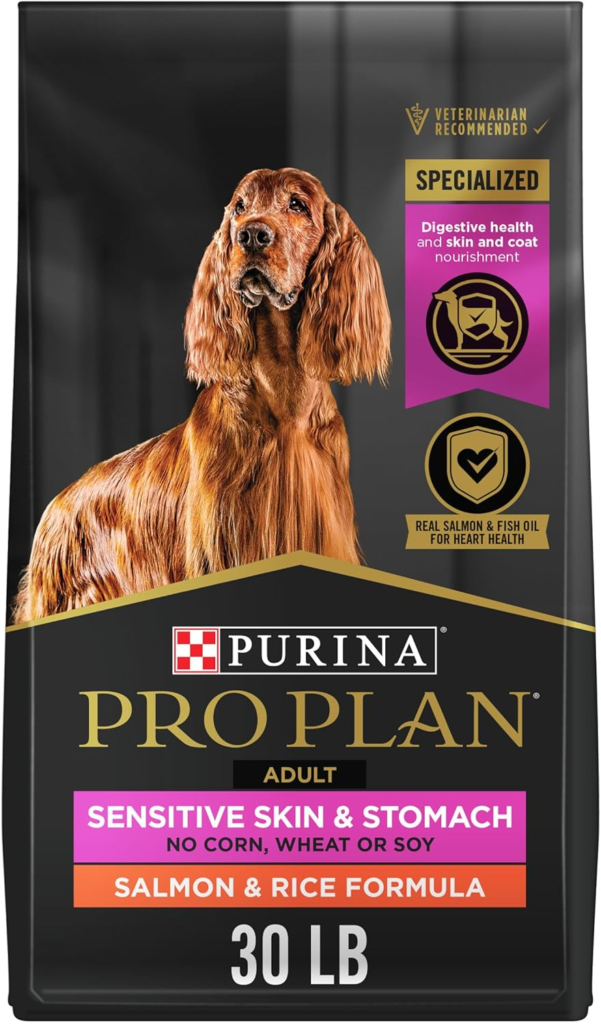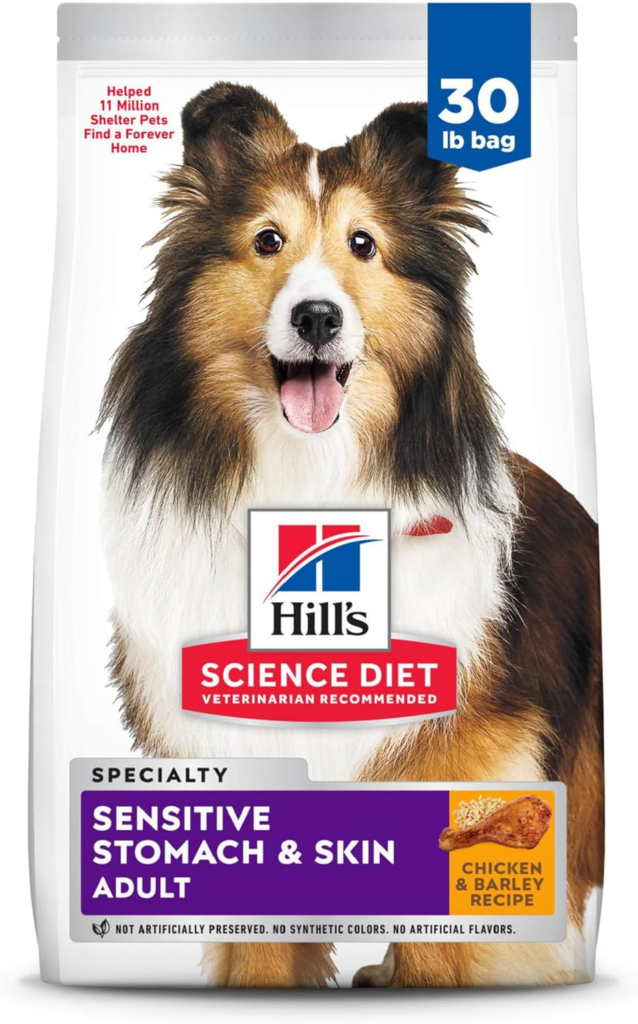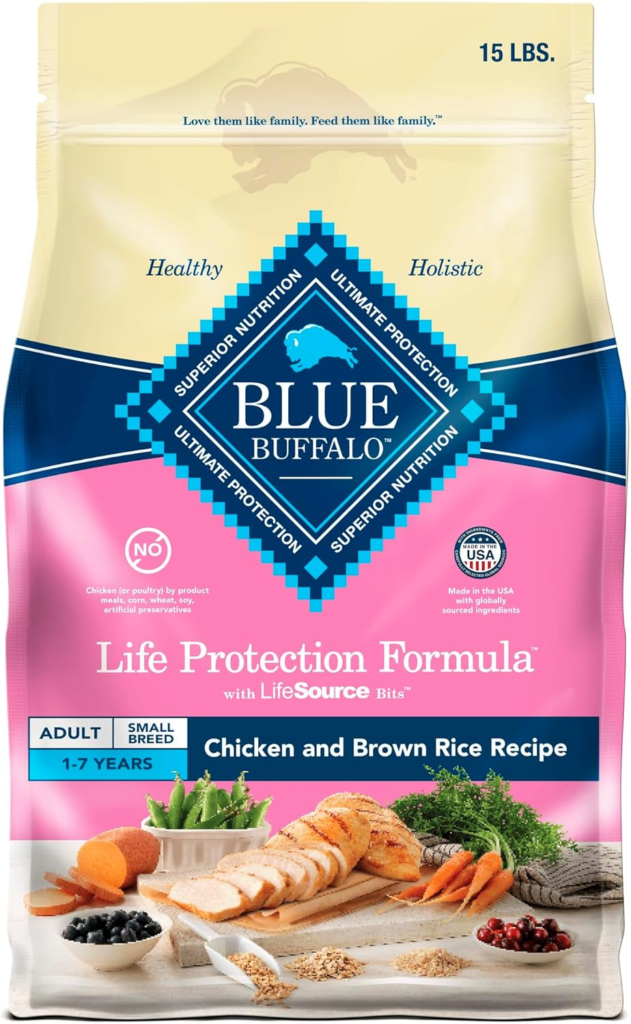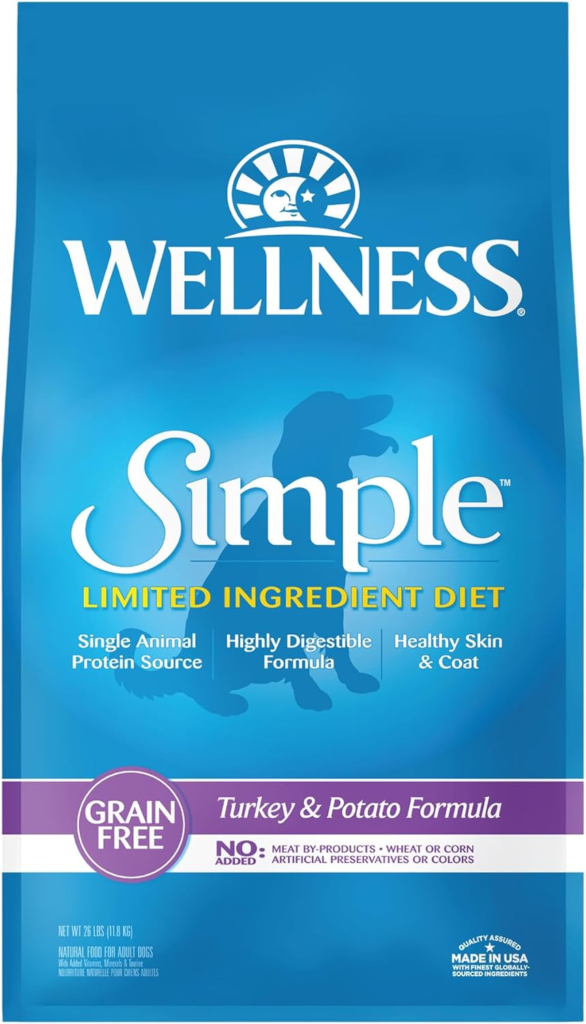As a dog owner who’s dealt with canine skin sensitivities, I know how crucial it is to find the right diet for our furry friends with allergies. The proper dry dog food can make an enormous difference in your pet’s comfort and overall health.
Canine skin allergies can show up in various ways:
- Intense itching
- Redness and inflammation
- Hair loss
- Hot spots
- Recurring ear infections
While environmental factors can trigger these issues, food sensitivities often play a significant role. Common allergens in dog food include proteins like chicken or beef, as well as grains such as wheat or corn.
Key Factors in Choosing Allergy-Friendly Dog Food
When selecting a dry dog food for a pet with skin allergies, keep these crucial factors in mind:
Novel Protein Sources
Opting for proteins your dog hasn’t been exposed to before can help reduce allergic reactions. Look for options like:
- Salmon
- Duck
- Venison
- Rabbit
These novel protein sources are less likely to trigger an allergic response in dogs sensitive to more common meats.
Limited Ingredients
Foods with fewer ingredients decrease the chance of encountering allergens. Limited ingredient diets (LIDs) typically contain:
- A single protein source
- One carbohydrate source
- Essential vitamins and minerals
This simplicity makes it easier to identify and avoid problem ingredients.
Omega Fatty Acids
Foods rich in omega-3 and omega-6 fatty acids support skin health and reduce inflammation. Look for ingredients like:
- Fish oil
- Flaxseed
- Chia seeds
These nutrients help maintain a healthy skin barrier and can reduce itching and inflammation.
Avoid Common Allergens
Many dogs are sensitive to:
- Chicken
- Beef
- Dairy
- Wheat
- Soy
Steering clear of these ingredients can be useful for dogs with skin allergies.
Digestive Support
Probiotics and easily digestible carbohydrates can improve overall gut health, which is closely linked to skin health. Look for foods that include:
- Probiotics (beneficial bacteria)
- Prebiotics (fiber that feeds useful bacteria)
- Easily digestible carbs like sweet potatoes or pumpkin
Top Dry Dog Foods for Skin Allergies
Now, let’s explore some top-rated dry dog foods specifically formulated for dogs with skin allergies.
1. Purina Pro Plan Sensitive Skin and Stomach

Purina Pro Plan’s Sensitive Skin and Stomach formula stands out as a top choice for dogs with skin allergies. Here’s why:
Salmon as the First Ingredient: This novel protein source is rich in omega-3 fatty acids, excellent for skin health. Salmon provides high-quality protein while being less likely to trigger allergies compared to chicken or beef.
Easily Digestible Carbohydrates: Oatmeal and rice provide gentle, easily digestible energy sources. These carbs are less likely to cause digestive upset or contribute to skin issues.
No Common Allergens: This formula is free from corn, wheat, and soy, reducing the risk of allergic reactions. It’s also made without artificial colors, flavors, or preservatives.
Probiotic Support: The food is fortified with live probiotics to enhance digestive health, which can indirectly benefit skin condition. A healthy gut often leads to healthier skin.
Skin-Nourishing Nutrients: Contains omega-6 fatty acids and vitamin A to support skin and coat health. These nutrients work together to promote a shiny coat and healthy skin.
Many dog owners report significant improvements in their pets’ skin and coat condition after switching to this food. The salmon-based formula is particularly useful for dogs with chicken or beef allergies.
This is the best dry food on the market, and you can get it today on Amazon.
2. Hill’s Science Diet Sensitive Stomach & – Skin

Hill’s Science Diet offers a formula that’s highly regarded by veterinarians for dogs with sensitive stomachs and skin issues:
High-Quality Protein: Chicken is the first ingredient, providing essential amino acids. While chicken can be an allergen for some dogs, many with skin sensitivities do well on this formula.
Prebiotic Fiber: The food contains prebiotic fiber to support digestive health, which can have a positive impact on skin condition. A healthy digestive system helps confirm proper nutrient absorption.
Vitamin E and Omega-6 Fatty Acids: These nutrients work together to nourish the skin and promote a healthy coat. They help maintain the skin’s natural barrier function.
No Artificial Additives: Free from artificial colors, flavors, or preservatives, reducing the risk of reactions to synthetic ingredients.
Antioxidant Benefits: Clinically proven antioxidant benefits support overall health, including immune function which can impact skin health.
This food is highly digestible and formulated to provide skin-nourishing nutrients. It’s reputation among veterinarians makes it a trustworthy choice for dogs with food sensitivities.
This is the best top-rated dry food on the market, and you can get it today on Amazon.
3. Blue Buffalo Life Protection Formula

Blue Buffalo’s Life Protection Formula for small breeds is an excellent option for smaller dogs with skin allergies:
Real Chicken: The first ingredient, providing high-quality protein. While some dogs may be sensitive to chicken, many thrive on this protein source.
LifeSource Bits: A blend of antioxidants, vitamins, and minerals to support overall health. These cold-formed bits help preserve the potency of nutrients.
Omega Fatty Acids: Rich in omega-3 and omega-6 fatty acids for skin and coat health. These essential fats help reduce inflammation and promote a shiny, healthy coat.
No By-Products or Fillers: Free from chicken by-product meals, corn, wheat, or soy. This helps reduce the risk of allergic reactions to common problem ingredients.
Natural Ingredients: Contains no artificial flavors or preservatives, focusing on wholesome nutrition.
This formula is designed to meet the higher energy needs of small breed dogs while supporting their skin and coat health. The small kibble size is ideal for smaller mouths, making it easier for little dogs to eat and digest.
4. Royal Canin Veterinary Diet Hydrolyzed Protein

For dogs with severe food allergies, Royal Canin’s Veterinary Diet Hydrolyzed Protein can be a game-changer:
Hydrolyzed Soy Protein: The protein in this food is broken down into small components less likely to trigger allergies. This process makes the protein less recognizable to the immune system, reducing the chance of an allergic response.
Omega-3 Fatty Acids: EPA and DHA help manage skin sensitivity and reduce inflammation. These essential fats are crucial for maintaining healthy skin and coat.
Reinforced Skin Barrier: Essential nutrients support the skin’s natural protective barrier. This helps prevent allergens and irritants from penetrating the skin.
B Vitamins and Amino Acids: These nutrients support overall skin health and function. They play crucial roles in skin cell regeneration and repair.
This prescription diet needs veterinary authorization but can be highly effective for dogs with extreme food sensitivities and skin issues. It’s often recommended as a diagnostic tool to identify food allergies.
5. Wellness Simple Limited Ingredient Diet

Wellness Simple offers limited ingredient diets ideal for dogs with food sensitivities:
Single Protein Source: Options include salmon, lamb, turkey, or duck. This allows you to choose a protein your dog hasn’t been exposed to before, reducing the risk of allergic reactions.
Limited Ingredients: The formula minimizes potential allergens by using a short list of carefully selected ingredients. This makes it easier to identify and avoid problem ingredients.
Digestive Health Support: Includes probiotics and prebiotics to promote a healthy gut. Good digestive health often translates to better skin health.
Omega Fatty Acids: Flaxseed provides omega fatty acids for skin and coat health. These essential fats help reduce inflammation and promote a shiny, healthy coat.
No Common Allergens: Free from wheat, corn, soy, artificial preservatives, or flavors. This reduces the risk of reactions to common problem ingredients.
The limited ingredient approach makes it easier to identify and avoid problem ingredients for dogs with allergies. This can be particularly helpful when you’re trying to pinpoint specific food sensitivities.
Transitioning to a New Food
When introducing any new food to your dog’s diet, it’s crucial to do so gradually. Here’s a recommended transition schedule:
- Days 1-2: 75% old food, 25% new food
- Days 3-4: 50% old food, 50% new food
- Days 5-6: 25% old food, 75% new food
- Day 7: 100% new food
This gradual transition helps prevent digestive upset and allows you to watch your dog for any adverse reactions to the new food. If you notice any signs of digestive distress or increased skin irritation during the transition, slow down the process or talk to your veterinarian.
Monitoring Your Dog’s Progress
After switching to a new food, keep a close eye on your dog’s skin condition. Look for improvements such as:
- Reduced itching and scratching
- Less redness or inflammation
- Improved coat shine and texture
- Fewer hot spots or skin lesions
It may take several weeks to see significant improvements, so be patient. Keep a journal to track changes in your dog’s skin condition, energy levels, and overall health.
This can be helpful information to share with your veterinarian.
If you don’t notice positive changes after 6-8 weeks, talk to your veterinarian about trying a different food or exploring other treatment options. Remember, every dog is unique, and what works for you may not work for another.
Beyond Diet: Additional Skin Care Tips
While choosing the right food is crucial, there are other steps you can take to support your dog’s skin health:
Regular Grooming: Brush your dog regularly to distribute natural oils and remove allergens from the coat. This also gives you a chance to inspect your dog’s skin for any new issues.
Bathing: Use a hypoallergenic shampoo recommended by your vet to soothe irritated skin. Be careful not to bathe too frequently, as this can strip the skin of natural oils.
Supplements: Consider adding fish oil or other omega-3 supplements to your dog’s diet for extra skin support. Always talk to your veterinarian before starting any new supplements.
Environmental Management: Minimize exposure to environmental allergens by keeping your home clean and using air purifiers. Regularly wash your dog’s bedding in hot water to remove allergens.
Flea Prevention: Maintain a strict flea prevention regimen, as flea allergies can exacerbate skin issues. Even a single flea bite can cause severe itching in allergic dogs.
Stress Reduction: Stress can worsen skin conditions in some dogs. Provide plenty of exercise, mental stimulation, and a consistent routine to help reduce stress.
The Importance of Professional Guidance
While this guide provides a comprehensive overview of dry dog foods for skin allergies, it’s important to remember that every dog is unique. What works for you may not work for another.
Always talk to your veterinarian before making significant changes to your dog’s diet, especially if they have ongoing health issues or severe allergies.
Your vet can provide personalized recommendations based on your dog’s specific needs and may suggest allergy testing to identify specific triggers. In some cases, a combination of dietary changes and medical treatments may be necessary to fully address skin allergy issues.
Consider working with a veterinary dermatologist if your dog’s skin issues are severe or persistent. These specialists have advanced training in diagnosing and treating skin conditions in animals.
Addressing Common Concerns
What if my dog doesn’t like the new food?
Some dogs can be picky eaters, especially when introduced to a new food. Try these tips:
- Mix a small amount of low-sodium chicken broth or warm water with the kibble to enhance the aroma.
- Gradually increase the proportion of new food to old food over a longer period.
- Offer the new food at room temperature to enhance it’s smell and palatability.
How long should I try a new food before deciding if it’s working?
Give any new food at least 6-8 weeks before making a judgment. Skin cells take time to regenerate, so improvements may not be immediately visible.
Keep a log of your dog’s symptoms to track progress over time.
Can I supplement my dog’s dry food with home-cooked meals?
While home-cooked meals can be a healthy addition to your dog’s diet, it’s crucial to confirm they’re nutritionally balanced. Consult with a veterinary nutritionist to develop a safe and effective home-cooking plan that complements your dog’s dry food.
What if my dog’s allergies seem to be getting worse?
If your dog’s symptoms worsen or new symptoms develop, talk to your veterinarian immediately. This could indicate a more serious underlying condition or the need for extra treatment.
People Also Asked
What are the most common food allergens for dogs?
The most common food allergens for dogs include beef, dairy, chicken, wheat, egg, lamb, soy, pork, rabbit, and fish. However, any food ingredient can potentially cause an allergic reaction in sensitive dogs.
How can I tell if my dog has a food allergy or environmental allergy?
Distinguishing between food and environmental allergies can be challenging. Food allergies often cause year-round symptoms and may include gastrointestinal issues.
Environmental allergies are more likely to be seasonal.
Your veterinarian can help decide the cause through elimination diets or allergy testing.
Are grain-free diets better for dogs with skin allergies?
Not necessarily. While some dogs may benefit from grain-free diets, true grain allergies are relatively rare in dogs.
Many dogs with skin issues do well on diets that include grains.
It’s more important to identify and avoid your dog’s specific allergens.
Can changing my dog’s diet cure their skin allergies?
While changing to an suitable diet can significantly improve skin allergies, it may not completely cure them. Many dogs need a combination of dietary management and other treatments to control their symptoms effectively.
How long does it take to see improvement in my dog’s skin after changing their food?
It typically takes 6-8 weeks to see significant improvements in your dog’s skin after changing their food. However, some dogs may show signs of improvement sooner, while others may take longer.
Is raw food better for dogs with skin allergies?
There’s no scientific evidence that raw diets are better for dogs with skin allergies. In fact, raw diets can pose health risks because of potential bacterial contamination.
Always talk to your veterinarian before considering a raw diet.
Can I give my dog human food to help with their skin allergies?
Some human foods, like plain cooked salmon or sweet potato, can be useful for dogs with skin issues. However, it’s crucial to introduce any new foods gradually and in consultation with your veterinarian to confirm they’re safe and suitable for your dog.
Are hypoallergenic dog foods worth the extra cost?
For dogs with diagnosed food allergies, hypoallergenic foods can be worth the investment as they can significantly improve quality of life and reduce the need for other treatments. However, not all dogs with skin issues need hypoallergenic diets.
Can probiotics help with my dog’s skin allergies?
Probiotics can support overall gut health, which may indirectly benefit skin health. Some studies suggest probiotics can help reduce allergy symptoms in dogs, but more research is needed. Discuss with your vet whether probiotics might be useful for your dog.
How often should I bathe my dog with skin allergies?
The frequency of bathing depends on your dog’s specific needs. Over-bathing can dry out the skin and worsen symptoms. Generally, bathing every 1-2 weeks with a veterinarian-recommended hypoallergenic shampoo is enough.
Always follow your vet’s advice.
Key Takeaways
- Choose foods with novel protein sources and limited ingredients to minimize allergen exposure.
- Look for formulas rich in omega fatty acids to support skin health.
- Gradually transition to new foods to prevent digestive upset.
- Monitor your dog’s progress and be patient – improvements may take several weeks to become obvious.
- Combine dietary changes with proper grooming and environmental management for best results.
- Always talk to your veterinarian for personalized advice and treatment plans.